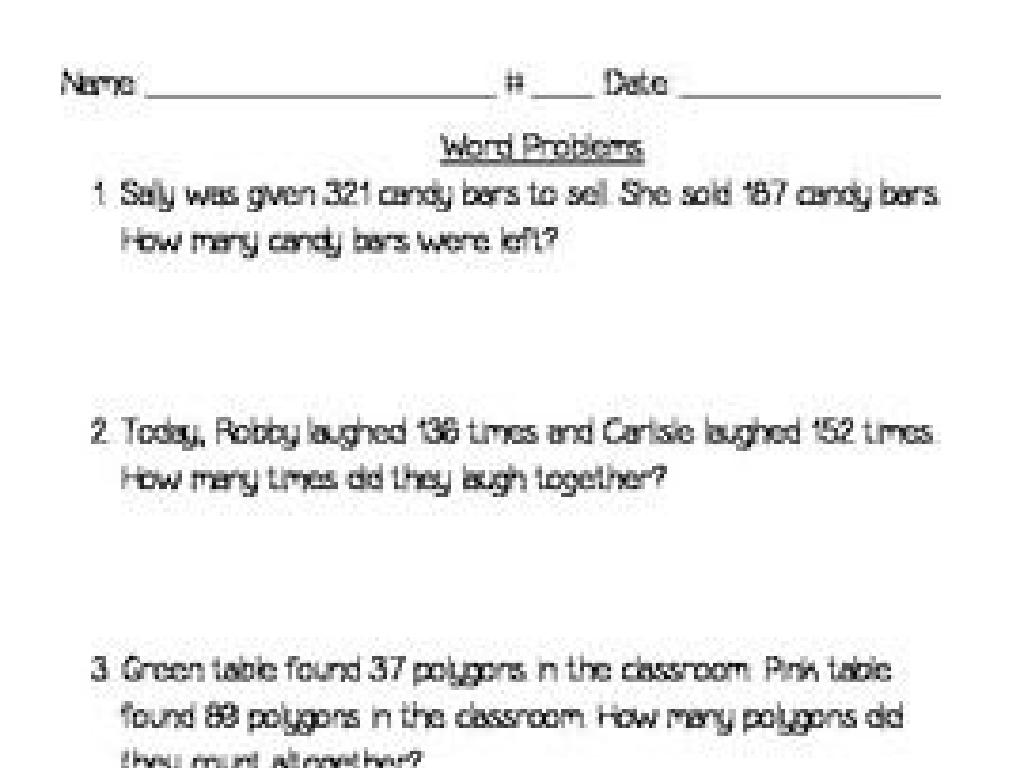Identify The First, Second, And Last Sound In A Word
Subject: Language arts
Grade: First grade
Topic: Blending And Segmenting
Please LOG IN to download the presentation. Access is available to registered users only.
View More Content
Exploring Sounds in Words
– Play with word sounds
– Why sounds help us
– Understanding sounds improves reading and writing
– Find the first sound
– The first sound in ‘cat’ is /k/
– Find the last sound
– The last sound in ‘dog’ is /g/
|
This slide introduces the concept of blending and segmenting sounds to first graders. Emphasize the fun aspect of playing with sounds as a way to engage the students. Explain how recognizing individual sounds in words is a crucial step towards developing reading and writing skills. Use simple, familiar words to demonstrate finding the first and last sounds. For example, ask students to identify the first sound in ‘cat’ and the last sound in ‘dog’. Encourage them to practice with different words and to listen carefully to the sounds they hear at the beginning and end of each word. Prepare to guide them through exercises where they will identify these sounds in various words during the lesson.
Exploring Sounds in Words
– Words are made of sounds
– Like building blocks, each sound combines to create a word.
– Listen for beginning, middle, end
– The first sound is at the start, the middle sound is in the center, and the last sound is at the end.
– Sounds blend to form words
– When we say the sounds one after another quickly, they blend together to make a whole word.
|
This slide introduces the concept that words are composed of individual sounds, which can be heard at the beginning, middle, and end of words. Emphasize the importance of listening carefully to identify each sound. Use examples like ‘cat’ where ‘c’ is at the beginning, ‘a’ is in the middle, and ‘t’ is at the end. Practice with the class by slowly saying a word and then saying it faster to demonstrate how the sounds blend together to form the word. Encourage students to practice with different words and to listen for each sound’s position within the word.
Identifying the First Sound in Words
– First sound: start of a word
– Example: ‘cat’ starts with ‘c’
– ‘c’ as in ‘cat’, ‘k’ as in ‘kite’
– Practice with different words
– Find first sounds in ‘dog’, ‘mat’, ‘sun’
– Listening game for first sounds
– We’ll play a game to identify the first sounds
|
This slide introduces the concept of identifying the first sound in a word, which is crucial for developing phonemic awareness in young learners. Start by explaining that the first sound is what we hear at the beginning of a word. Use simple examples like ‘cat’ to illustrate this point. Engage the class by practicing with a variety of words, asking them to identify the first sound they hear. Incorporate a listening game where you say a word and the students identify the first sound, making it interactive and fun. This activity will help students in blending and segmenting words, foundational skills for reading.
Practice: Finding the First Sound
– Look at the picture together
– Say the object’s name aloud
– Identify the first sound
– The first sound in ‘dog’ is /d/, as in ‘duck’
– Practice with examples
– ‘dog’ starts with /d/, ‘sun’ with /s/, ‘hat’ with /h/
|
This slide is designed to help students practice identifying the initial sounds of words, which is a fundamental skill in phonemic awareness. Start by showing a picture and saying the name of the object together to ensure correct pronunciation. Then, focus on the first sound of the word. Use hand motions to signal the first sound. For example, with ‘dog’, emphasize the /d/ sound and make a ‘d’ motion with your hand. Repeat this process with ‘sun’ and ‘hat’, and encourage the students to do the same. Make sure to praise their efforts to build confidence. For homework, ask students to find objects at home and practice saying the first sound.
Finding the Second Sound in Words
– Understanding the second sound
– It’s the sound that comes right after the first one.
– Example: The word ‘dog’
– In ‘dog’, the first sound is ‘d’, and the second is ‘o’.
– Practice with different words
– We’ll try this with more words to get better.
– Listen and identify the second sound
– Focus on the sound that comes after the first.
|
This slide is aimed at helping first graders recognize the second sound in a word, which is crucial for their phonemic awareness and reading skills. Start by explaining that the second sound follows the first sound. Use ‘dog’ as an example, emphasizing the ‘o’ sound that comes after the initial ‘d’. Engage the class by practicing with a list of simple words, asking students to listen carefully and identify the second sound. This activity will reinforce their understanding of word structure and help them in blending sounds to read words. Encourage participation and provide positive feedback to build their confidence.
Practice: Finding the Second Sound
– Say the word, then first and second sounds
– For ‘frog’, we say ‘f-r’, ‘r’ is second
– ‘frog’ starts with ‘f’, but the second sound is ‘r’
– Practice with words ‘frog’, ‘block’, ‘tree’
– ‘block’ starts with ‘b’, the second sound is ‘l’; ‘tree’ starts with ‘t’, second sound is ‘r’
– Listen and repeat the sounds together
|
This slide is for a class activity focused on identifying the second sound in a word. Start by modeling the activity with the word ‘frog’. Emphasize the ‘f’ sound, then the ‘r’ sound, and clarify that ‘r’ is the second sound. Repeat the process with ‘block’ and ‘tree’, ensuring to articulate the first and second sounds distinctly. Encourage the students to listen carefully and then repeat after you. This exercise helps students with phonemic awareness, a crucial skill in reading and spelling. Possible activities: 1) Have students find the second sound in their names. 2) Use objects in the classroom to practice. 3) Pair students to practice with each other. 4) Play a game where you say a word, and students hold up 1 or 2 fingers to signal the first or second sound.
Identifying the Last Sound in Words
– What’s the last sound?
– The last sound is the one you hear at the end of a word.
– ‘Cat’ ends with ‘t’
– In the word ‘cat’, the sound you hear at the end is ‘t’.
– Listen for the last sound
– Ask yourself: What’s the sound at the end of ‘cat’?
– Practice with different words
– Try finding the last sound in ‘dog’, ‘hat’, and ‘run’.
|
This slide is aimed at helping first graders identify the last sound in a word, which is an essential skill in phonemic awareness. Start by explaining that every word is made up of different sounds and the last sound is the one we hear at the end. Use ‘cat’ as an example and emphasize the ‘t’ sound. Encourage the students to listen carefully to the last sound in ‘cat’ and other familiar words. Provide additional examples and conduct a class activity where students say words and identify the last sounds together. This will help them in reading and spelling as they learn to segment and blend sounds.
Practice: Finding the Last Sound
– Listen to the word carefully
– Repeat the word aloud
– Identify the last sound
– For ‘bed’, the last sound is ‘d’
– Practice with examples
– Try ‘pig’ (last sound ‘g’), ‘cup’ (last sound ‘p’)
|
This slide is aimed at helping first graders practice identifying the last sound in a word, which is an essential skill in phonemic awareness. Start by saying a word clearly and then repeating it with the students. Encourage them to articulate the word and listen for the final sound. Use examples like ‘bed’, where ‘d’ is the last sound, and guide them to find the last sounds in ‘pig’ and ‘cup’. Make sure to correct gently and praise their efforts to build confidence. For further practice, you can use additional words and even introduce a fun activity where students find the last sound in their names or objects around the classroom.
Let’s Play a Sound Game!
– Listen to the word I say
– Tell me the first, second, and last sounds
– For ‘cat’, the sounds are /c/ /a/ /t/
– Get it right and draw a smiley face
– A reward for correct answers
– Have fun learning sounds!
|
This interactive game is designed to help first graders identify the first, second, and last sounds in words, which is a key skill in blending and segmenting. As you say a word, prompt the students to listen carefully and articulate each sound they hear. For example, when you say ‘cat’, they should respond with /c/, /a/, and /t/. If they identify the sounds correctly, they get to draw a smiley face on the board. This visual reward system not only makes the activity enjoyable but also reinforces positive learning experiences. Encourage participation from all students and provide guidance and praise as they work through the sounds. This activity will help build their phonemic awareness, a foundational reading skill.
Class Activity: Sound Detective
– You are sound detectives now
– Listen carefully to the words
– Find the first, second, last sounds
– For ‘cat’, the sounds are ‘c’, ‘a’, ‘t’
– Use your magnifying glass on the worksheet
– Pretend to magnify words and find sounds
|
In this engaging class activity, students will practice identifying the initial, medial, and final sounds in words by pretending to be detectives. As the teacher, you will say words aloud, and students will use a worksheet with pictures or words to identify the sounds. Provide them with a paper magnifying glass cutout to make the activity more interactive. Possible words to use: ‘dog’, ‘pen’, ‘hat’, ‘sun’, ‘pig’. Encourage students to say the sounds out loud as they ‘find’ them with their magnifying glasses. This activity helps with phonemic awareness and prepares students for reading by understanding the sounds that make up words.






